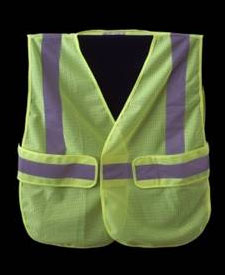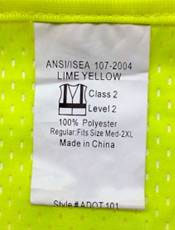Safety Requirements
Safety Requirements
Safety Briefing Overview
Adopt a Highway volunteers are required to complete the following steps prior to each litter clean up activity:
- Read the Safety Briefing.
- Watch the Safety Briefing video below before each litter clean up activity.
- Acknowledge reading the Safety Briefing and watching the safety briefing video before entering ADOT right of way. Print the Adopt a Highway Volunteer Registration Form and return it to the designated ADOT office listed on your permit after your clean up.
Safety Vests
Volunteers are required to wear ANSI Class II Safety Vests, which meet the requirements for working on the right of way of any roadway open to public travel.
If your group is checking out vests for your ADOT Adopt a Highway volunteer cleanup, Please fill out the Adopt a Highway Vests Check Out Sheet and send it to your ADOT contact in the designated ADOT District Office listed on your application.


Safety Briefing
Safety Briefing Video
Guidelines for Litter Removal
Be Vigilant and Be Cautious
Adopt a Highway volunteers are to follow these safety guidelines when participating in litter removal activities along Arizona’s highways. Each volunteer or participant must be given copies of this briefing prior to arrival at the worksite. Our combined efforts to keep Arizona beautiful are going a long way toward improving the appearance of our highways; however, your safety is our #1 priority. Make it yours, too! There may be many dangerous creatures or situations out on the Arizona Road. Below are some of the more common dangers to be aware of.
- Participants should assemble in an area away from the designated worksite and carpool to reduce the number of cars at the litter pickup site. Park at least 25 to 30 feet from the roadway edge.
- Wear light-colored, comfortable clothing and cover up as much skin as you can. Carry a handkerchief. Wear white socks, long pants and long-sleeved shirts if possible. Avoid wearing shiny jewelry or leather that may annoy Africanized bees. Avoid odoriferous body products. Use a sunscreen with little to no odor. Gloves, hats, hard-soled shoes or boots that cover the ankles are strongly recommended. Participants should not wear shorts or tank tops.
- ANSI Class II safety vests must be worn by ALL participants at ALL times during cleanup activities.
- Do not pick up litter within six feet of the roadway or on/under bridges, culverts or structures of any kind. Keep away from any highway construction or maintenance projects.
- Pick up litter only during daylight hours and good weather. Do not pick up litter without notifying your ADOT representative ahead of time. Only remove loose trash and debris (e.g., paper, plastics, cardboard and aluminum) tire shards or other bulk items may be left next to filled trash bags.
- Do not pick up anything you are unfamiliar with or that appears questionable, including any sealed bottle of any kind. These may contain methamphetamine waste (See “Be Alert to Meth Waste”) or urine. Do not pick up other hazardous materials such as car batteries, animal carcasses or needles. Do not pick up glass or other sharp items that may cut you or the trash bag.
- Cross the highway only at designated locations and cross as seldom as possible. Determine designated crossing locations prior to starting work.
- Do not distract motorists with horseplay or abrupt erratic movements. Horseplay of any kind is forbidden. The highways are potentially very dangerous. Do not bring pets, golf carts, ATVs or other potential distractions to the right of way.
- Work as a group facing oncoming traffic. It is a good idea for each group to have a lookout.
- No one under the influence of alcohol or narcotics is allowed to participate in the cleanup activity.
- Use caution when you encounter cacti, animals, steep slopes, sharp rocks, insects, barbed wire, heavy traffic and any other unusual circumstances.
- Ensure that enough water is available and in sufficient quantity to meet your group’s needs.
- At least one person in your group should be certified in CPR and have experience in administering first aid. Ensure that first-aid kits are available and that transportation is available to the nearest medical facility (most local fire stations offer CPR certification). If you have severe allergies to anything, always carry appropriate medicine prescribed by your physician when outdoors.
- All participants will review ADOT Adopt a Highway Safety Guidelines prior to reporting to the jobsite.
- Participants below the age of 12 are not permitted at the worksite.
Methamphetamine Manufacturing Waste
Large quantities of medicine boxes, respirator masks, rubber gloves, rubber hoses, clamps, Pyrex or Corning glass containers, pill residue (putty looking substance, pink to red in color), other containers or kitty litter bags with rubber hoses attached, red-stained cloths or coffee filters, and any containers with a powdery residue, gasoline additives, or rubbing alcohol may be an indication of meth manufacturing.
Here is a new warning. Methamphetamine makers might also just use a plastic soda bottle, lye, starter fluid, ammonia nitrate, ether, acetone, and strips from lithium batteries to make what is called a “one-pot method” or “shake and bake.” Production on a small scale can be very dangerous.
DO NOT PICK UP ANY SEALED PLASTIC BOTTLES or any plastic bottles that appear to contain any questionable substance. If you come across items you suspect were used to make methamphetamine, stay away from them and notify your ADOT contact as to where they are.
If you come across any of the following items leave them alone and tell your ADOT contact where you saw them:
Blister Packs
Over-the-counter cold remedies containing ephedrine or pseudoephedrine are used to make meth. Unusually large quantities of these products or large numbers of “blister packs” being disposed of may indicate the presence of a meth lab.
Fuels
Coleman fuel, acetone, and muriatic acid are common ingredients used in meth labs. Other common chemicals are ethyl alcohol (denatured alcohol), ethyl ether (starting fluid), hydrogen peroxide, iodine crystals and paint thinner. Storage or disposal of large quantities gasoline, antifreeze or any of the above items can indicate the presence of a meth lab.
Box Lab
Meth labs can be contained inside a simple cardboard box or ice chest/cooler. Be alert for strange and powerful odors, piping attached to odd containers (like kitty litter bags), beakers, jars, and funnels.
The Cooked Product
When “cooked,” meth takes on the form of a white, tan or brown powder. Coffee filters are commonly used in the manufacture of meth. Finding filters stained unusually bright colors can be a sign of a meth lab. Common colors for stains on coffee filters are fluorescent red, green and blue,
Propane Tanks
This is a home grill propane bottle used to download ammonia. You can see the nozzle is blue. This blue color is due to the corrosive effect of ammonia on the gas valve. This propane tank is now a potential bomb, ready to explode.
Rattlesnake Bites
Take extra caution when walking in the desert or mountains, especially when the daytime temperature stays above 82 degrees Fahrenheit. Use caution at all times.
DO NOT HANDLE DEAD SNAKES OR THEIR SEVERED HEADS
A REFLEX STRIKE/BITE CAN OCCUR FOR HOURS AFTER THE SNAKE IS DEAD!
When disturbed, a snake vibrates its tail, and the rattle gives off a vibrant chi chi chi chi. Arizona has 17 species and subspecies of rattlesnakes.
TREATMENT AND FIRST AID
If bitten by a rattlesnake, stay calm and seek medical attention IMMEDIATELY! To keep your heart rate low, do not run or walk quickly.
Call 911 or the Poison Control Center at 800.222.1222.
- If bitten on the hand, remove all jewelry immediately before swelling begins.
- DON’T apply ice to the bite site or immerse the bite in a bucket of ice.
- DON’T use a constricting band or tourniquet. Do not restrict blood flow in any manner.
- DON’T try to capture the snake and take it to the hospital with the person who was bitten
Scorpion Stings
BE ALERT TO BITES AND STINGS SCORPION STINGS
All scorpions can sting, but only one scorpion in the US, the bark scorpion in Arizona, is classified as potentially deadly.
If someone in your group is stung and the scorpion cannot be identified, pay attention to the SIGNS AND SYMPTOMS.
The bark scorpion sting is extremely painful, but does not usually cause swelling or redness at the sting site. Victims describe the feeling as similar to having a piece of hot metal stabbed into their skin. If one of the other types of scorpions stings a person, victims say the pain is similar to that of a wasp, with local swelling and pain. The bark scorpion ranges in different shades of light brown. The male bark scorpion can grow to 8 cm in length, while the female only grows to 7 cm.
Call 911 or the Poison Control Center at 800.222.1222.
Bees
CONSIDER ANY HONEYBEES TO BE AFRICANIZED HONEYBEES OR KILLER BEES.
The Africanized honeybee looks just like a domestic or common European honeybee, and only highly trained bee specialists can tell them apart. Honeybees, wasps and yellow jackets sting to defend themselves or their nests. Avoid disturbing them. Africanized bees are not particular about where they establish a colony. They may nest in cavities like holes in the ground, crevices in rocks, discarded tires, a saguaro cactus or water meter boxes.
DON’T KICK OVER A ROCK OR ROLL OVER A LOG WITHOUT CHECKING FOR BEES.
Treat all bees like you would a rattlesnake, a scorpion or any venomous creature; be alert and stay away from them.
- Assume all bees are Africanized honeybees.
- Always be aware of your surroundings.
- “Bee prepared” and cover up as much skin as possible while on the Arizona roadside.
- Carry a handkerchief or scarf to cover your face if bees are riled and you can’t outrun them to safety.
- Wear light-colored clothing; do not wear perfume or strong smelling sunscreen.
- Most attacks are traced back to some kind of provocation. Don’t bug the bees!
If you are attacked, cover your head and run to the nearest place that will enable you to shut out the bees. A car, a truck or a house will work. If you choose a car or truck, close the outside vents and turn on the air conditioning to calm the bees. Do not dive under water. The bees will wait for you to surface and attack.
Ants
Ants can sting or bite and use their venom to kill smaller creatures or to keep intruders away. Therefore, the best prevention is to avoid stepping or sitting on their nests.
The severity of an insect sting reaction varies from person to person. A large, local reaction includes swelling and redness beyond the sting site. Although frightening in appearance, it will go away over several days.
The most serious reaction to an insect sting is an allergic one. All of these reactions require immediate medical attention. A severe allergic reaction, or “anaphylaxis,” may include one or more of the following symptoms:
- Hives, itching or swelling in areas other than the sting
- Tightness in the chest and difficulty breathing
- Hoarse voice or swelling of the tongue
- Dizziness or sharp drop in blood pressure
- Unconsciousness or cardiac arrest
If you have severe allergies to any insect, always carry appropriate medicine prescribed by your physician when outdoors.
Call 911 or the Poison Control Center at 800.222.1222.
